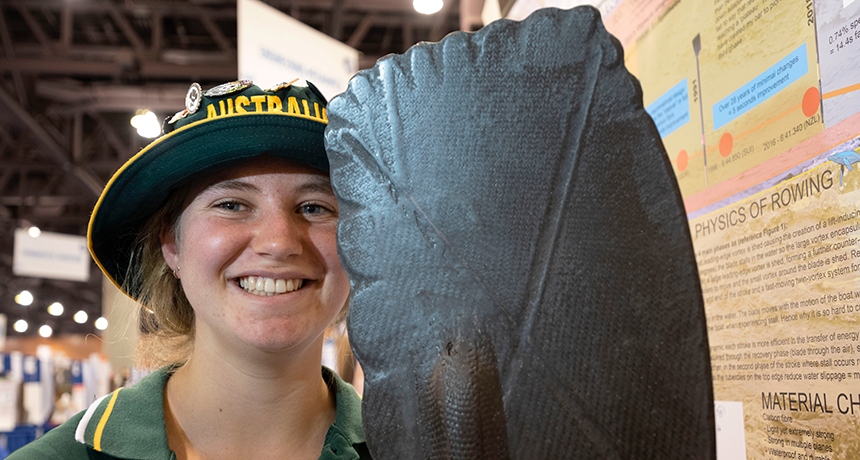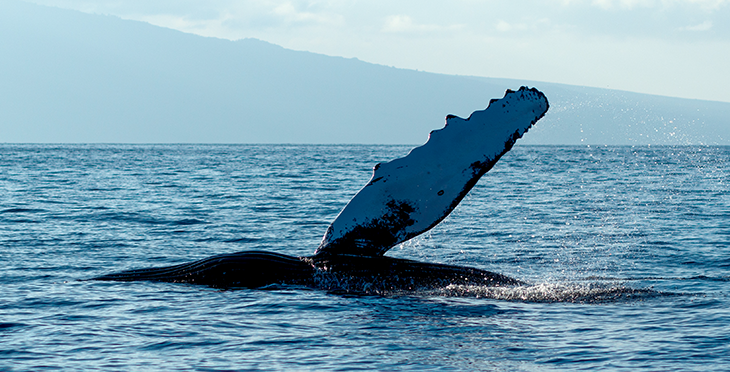Bumpy edges could be key to record-breaking oars
Innovative design was inspired by a whale’s flippers

Lucy Lake, an 18-year-old 12th-grader from Sydney, Australia, shows off her design for a better rower’s oar. Its scalloped edges were inspired by the bumpy flippers of humpback whales.
C. Ayers Photography/SSP
By Sid Perkins
PHOENIX, Ariz. — World-class rowers could someday shatter records for speed using oars whose design is based in part on a whale’s flippers.
Just ask athletes from any sport: World records aren’t easy to break. Sometimes a new way of training helps athletes gain an edge. But other times, new technology lends a hand, notes Lucy Lake. This 18-year-old rower attends Barker College in Sydney, Australia. And she knows more than a little about the history of her sport. Technology really helped rowers break speed records decades ago, she explains. Now she’s come up with an advance that she hopes may propel future rowers to shatter today’s records.
Rowing races typically cover a distance of 2 kilometers (1.24 miles). In 1952, says Lucy, the world record for rowing that distance was 8 minutes, 12 seconds. Back then, rowers used oars made of wood. But in the decades that followed, rowers started using oars made from lighter materials, including plastics. By 1988, the world-record time for rowing 2 kilometers had dropped to 6 minutes, 49 seconds. And since then, Lucy notes, not much progress has been made. The current record, set in 2016, is only 8 seconds faster than the record set 31 years ago.
It’s time for a new phase of oar evolution, Lucy says. To come up with a new oar design, she used computer software that analyzed the flow of water around objects. The sizeable bumps, or tubercles, along the front edges of a humpback whale’s flippers served as her inspiration.
On an oar blade, those bumps help a rower in several ways, Lucy’s science-fair research now shows.

First, those bumps help keep water that flows around the oar’s blade from breaking away from the blade as quickly as it would if the edges had been smooth. (That sort of breakaway is the same thing that happens when an aircraft wing stalls. A stall, in turn, causes a loss of the lift needed to keep a plane aloft.) So, in the first part of a rower’s stroke, bumpy-edged oar blades provide more power.
During the middle part of a rower’s stroke, an oar blade with bumpy edges creates less turbulence than a smooth-edged oar. Less turbulence means less drag — and thus more forward thrust, explains Lucy.
The final benefit comes when the rower removes oars from the water and brings them forward to begin the next stroke. During this phase, a bumpy-edged oar blade reduces how much drag the blade encounters as it moves through the air. Because air resistance is typically low, this provides only a small benefit, Lucy admits. But when a world record is on the line, she adds, every little bit helps.
Lucy showcased her new oar design here, last week, at the Intel International Science and Engineering Fair. This competition was created in 1950 by Society for Science & the Public. The 2019 event, sponsored by Intel, brought together more than 1,800 finalists from 80 countries. (The Society also publishes Science News for Students.)
Besides using computer software, Lucy field-tested her design. First, she made prototypes of smooth-edged and bumpy-edged oar blades. Then, she came up with oar handles that would fit both types of blades. This let her swap them out and test each type of blade without changing the length of the oar or the weight and feel of its handle.
On several days, she tested one type of oar blade, and then the other, over a distance of 500 meters (or almost 550 yards). During each test, she rowed, rowed, rowed her boat at 20 strokes per minute. That’s a common rate, she points out.
On average, Lucy finished the course 3.6 seconds faster when she used the bumpy-edged oar blades. If a world-class rower were able to do the same — and keep up the pace for a full 2 kilometers — they might be able to break the world record by as much as 14.4 seconds, she estimates.







